- Home
- slideshows
- miscellaneous
- My husband and I quit our jobs in NYC to bike across the country and relocate to LA. Here's exactly how we broke even in costs and job searched on the ride.
My husband and I quit our jobs in NYC to bike across the country and relocate to LA. Here's exactly how we broke even in costs and job searched on the ride.
Some of the creative ways we cut expenses and earned money along the journey

Not having any energy to do (or spend money) on anything but biking
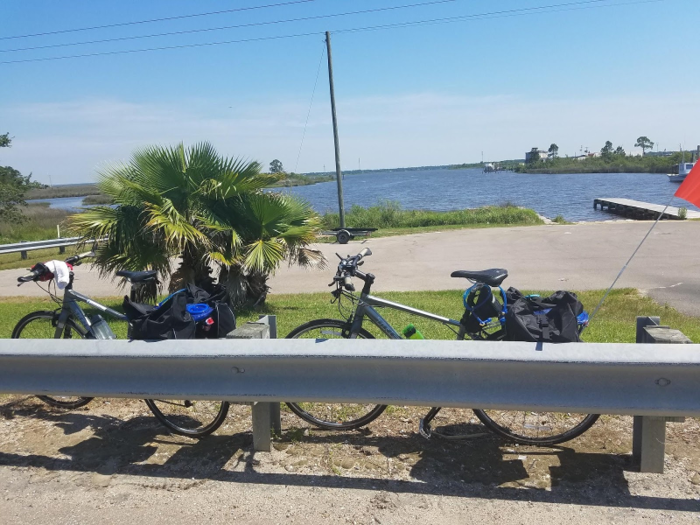
In many towns we passed through, people curious about what we were up to would stop to talk and tell us about local spots we should explore. "Oh, there's this great park just a few miles down the road," they'd say. But the reality was, a few miles — or even just a few blocks — was usually too much for us after dozens of miles of riding. Taking a look at our typical day, you can see why:
5:30-6 a.m.: Wake up
6:30-7:30 a.m.: Light breakfast and hit the road
2 hours in: Break for a full breakfast
Every 1-2 hours: Five- to 15-minute breaks
2:30-4 p.m.: Check in to our hotel
4-5:30 p.m.: Clean up, get our gear organized, and look for a local restaurant on Yelp or Google to order food or walk (very slowly) to dine in
6-7 p.m.: Dinner
8-9 p.m.: In bed to get eight to nine hours of sleep
Unless we had a rest day, we never saw much more than what we could from the seat of our bikes. The ride was the sightseeing — helping us save up to $1,408, according to the Budget Your Trip website's estimate for the average daily cost of entertainment for two budget travelers in the US.
That said, we did have biking expenses that added up to about $300 in costs — the price of getting 34 flat tires along the way.
Biking instead of driving
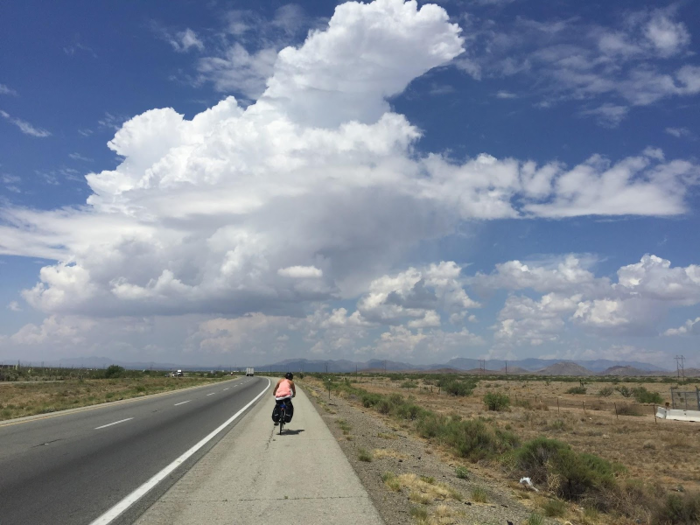
This one's a bit obvious, but other than on our rest days — and one time when we found ourselves taking a route that led to a narrow bridge with no space for pedestrians or bikes — we never stepped foot in a car. Sometimes, when temperatures soared above 90 degrees and the sun was beating down, we'd look longingly at pickup trucks and hope someone would offer us a ride (no such luck).
Helping us fight the temptation to get a ride via a ride-sharing app or take a cab when we were exhausted was that often we were simply out of reach. And even when we were within reach, ride-sharing apps like Lyft and Uber had not rolled out their larger-passenger vehicle rides — what we would have needed to accommodate us and our two bikes — where we were traveling. According to Investopedia, biking helped us save about $178.40 on gas.
Staying for free and in budget accommodations
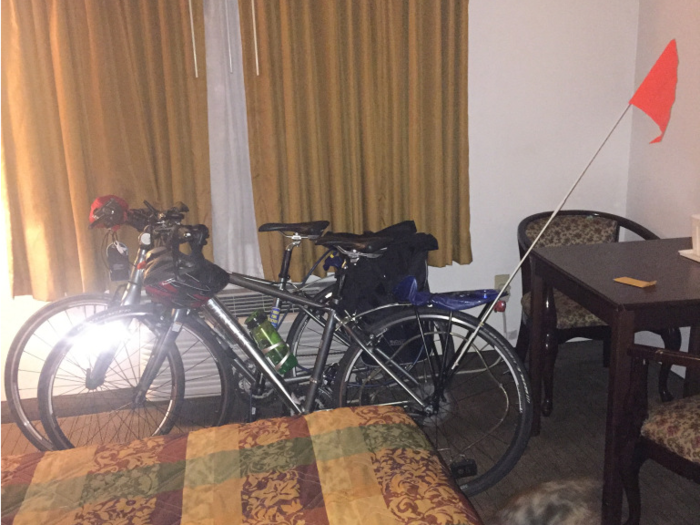
Between using IHG hotel rewards points my husband accumulated as an employee of an IHG property in New York City and through his IHG credit card as well as staying with family and friends along our route (with meals generously provided), we were able to stay for free for 17 of the 44 nights. Since many of the hotels we were paying for cost between $45 to $75 a night, these rewards points and loved ones helped us save at least $765 on accommodations. When we booked our free IHG nights, we'd opt for Holiday Inn Express properties, as these include free breakfast, where we'd load up on our first breakfast of the day and grab things like yogurt, bagels, and hardboiled eggs to eat somewhere along the road.
When we did pay for our hotels, we almost exclusively stayed in budget roadside motels and hotels booked the same day, helping us save between $51 to $81 below the average cost of accommodations — $126 per night, according to Investopedia.
Freelancing on the side
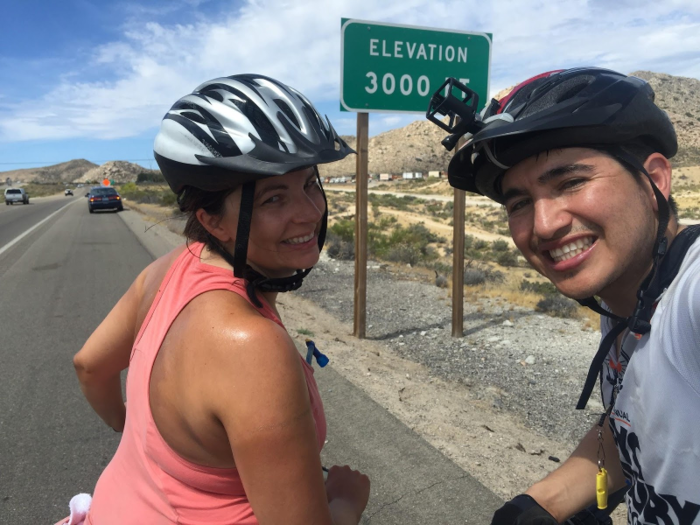
Our typical day on the road (see the schedule above) left very little time for looking for jobs, working, or even resting for that matter. But between the 65 to 83 miles of riding per day, I managed to fit in three assignments for one of my freelance writing clients and bring in $750 to help offset some of our travel costs.
Renting out our apartment and not paying for storage
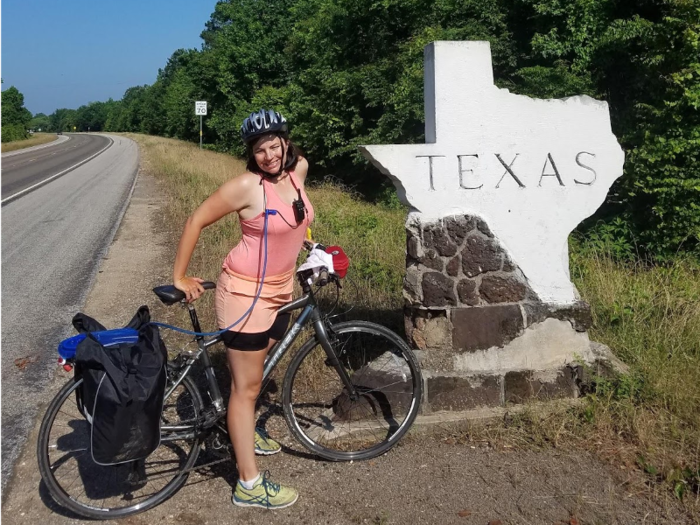
About a month before we headed out on the road, we packed up all of our personal belongings, rented out our furnished one-bedroom apartment, and stayed rent free in the guest room/office of my parents, who had a two-bedroom in the city, helping us bring in $2,000 to cover the apartment's monthly mortgage and maintenance. During our bike ride, we found another short-term renter to bring in an additional $5,643.
Renting our place furnished and storing our personal items at my parents' place helped us save about $150 a month on storage.
Keeping food costs low
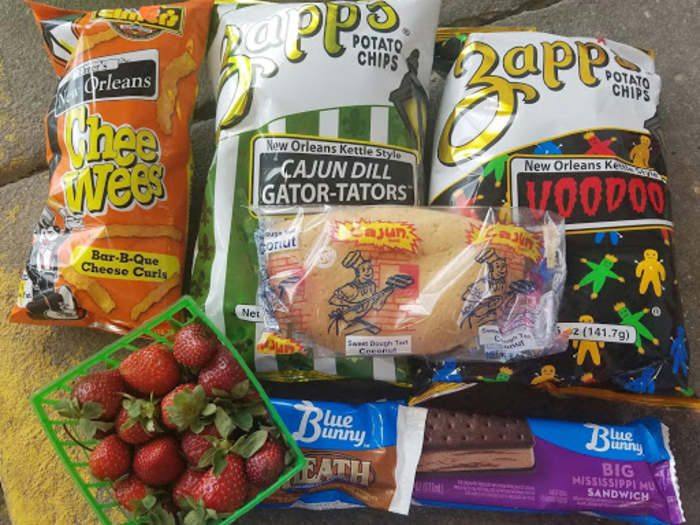
To keep our water expenses near zero, we filled two three-liter CamelBaks with free water and ice — from hotel ice machines and gas station and restaurant soda fountains — for almost the entire journey.
Ahead of our journey, we also bought Gatorade powder — which we'd dole out in two 20-ounce bottles (also filled with free ice and water) throughout the day — and energy chews in bulk, cutting back on the snacks and drinks we bought along the way.
While we never stayed anywhere with a true kitchen, we would occasionally — usually because there were no restaurants nearby or delivery options — buy frozen meals or boxed mac and cheese at a local dollar store, which we'd prepare in our hotel microwave, making meals that cost no more than a few dollars for the two of us.
Otherwise, we ate a lot of road food — gas station snacks, all-you-can-eat buffets, diners, and fast food — generally spending $10 to $25 on food for the two of us per day, with our one splurge meal being $47.25 on a rest day brunch in New Orleans.
Applying for jobs on the road
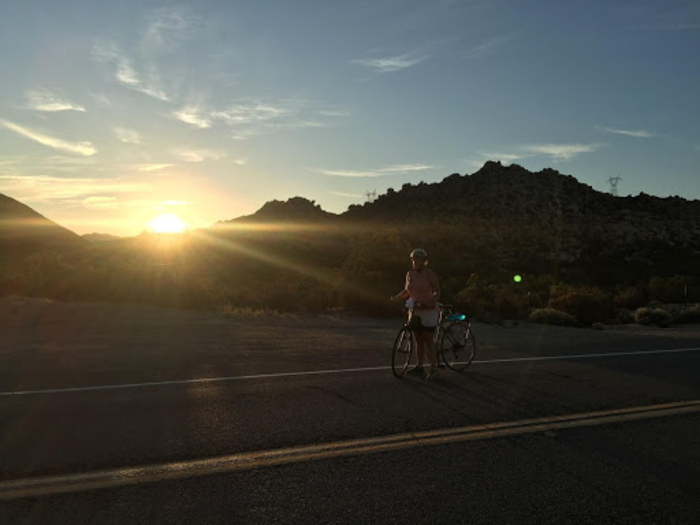
Over the course of seven months — from February until August of 2016 — I applied for 565 jobs, or about 81 jobs per month, until I landed the one I accepted based in LA.
During our 44 days on the road, my application volume dropped considerably — I applied to 21 jobs and took 10 phone and in-person interviews.
That said, the seeds I'd planted before we began our trek kept me busy during the journey. I scheduled my phone screeners for the late afternoon to have time to get to our hotel, cool off, and shower. (Once, I didn't make it and took the call from a gas station parking lot a couple of miles from our final destination.) I had to plan my first two in-person interviews around when I'd be near an airport so that I could fly to the interview and back.
For one, I was in rural Texas, and I asked for an interview the following week, giving me time to bike the couple hundred miles to El Paso, where I could fly to LAX. I planned my third in-person interview for a couple of days after we were set to finish the trip. The two in-person interviews brought with them about $725 in airfare expenses that I covered myself. Thankfully, family in LA let me stay for free and even drove me to my interviews.
While we'd hoped to have jobs lined up by the time we finished the ride so we could leave our old jobs on one coast for new ones on the other coast, things didn't work out that way. I tried a number of strategies — such as using a family member's LA address to appear like a local candidate and being upfront about wanting to relocate and willing to do so for the right opportunity — to get around the fact that I was applying for jobs in a city where I had no professional network.
But in the end, it all became easier once I was in the right place — where I'd be working if I were to get an offer. As it turned out, we had a lot more time on our hands now that we were unemployed and not biking like it was a full-time job, so it only took one month until my husband received an offer and I landed one right before Labor Day.
It was a big risk walking away from the professional networks and home we'd built in New York, yet the mental and physical benefits of taking the break from working and challenging my endurance are ones I will always be grateful for. There were days we faced 3,000-foot climbs and 50-miles-per-hour wind gusts pushing us backward, but still we inched forward.
Our one-and-a-half month adventure cost us four months of earning full-time salaries — a tradeoff for being able to make the adventure happen at all, given neither of us had the amount of vacation time needed to complete the ride. That's a reality here in the US, where one in four workers go without any paid holidays or vacation time at all, and the average worker receives a combo of 10 paid vacation days and six national holidays, according to CBS News.
Taking the time off before securing our new jobs is a privilege we were truly only able to afford thanks to the generosity of friends and family who helped us keep our costs low.
The happy ending to this chapter of our story is that we were able to see our combined incomes grow 67% while also trading New York's costly living for LA's slightly more affordable cost of living.
Popular Right Now
Popular Keywords
Advertisement